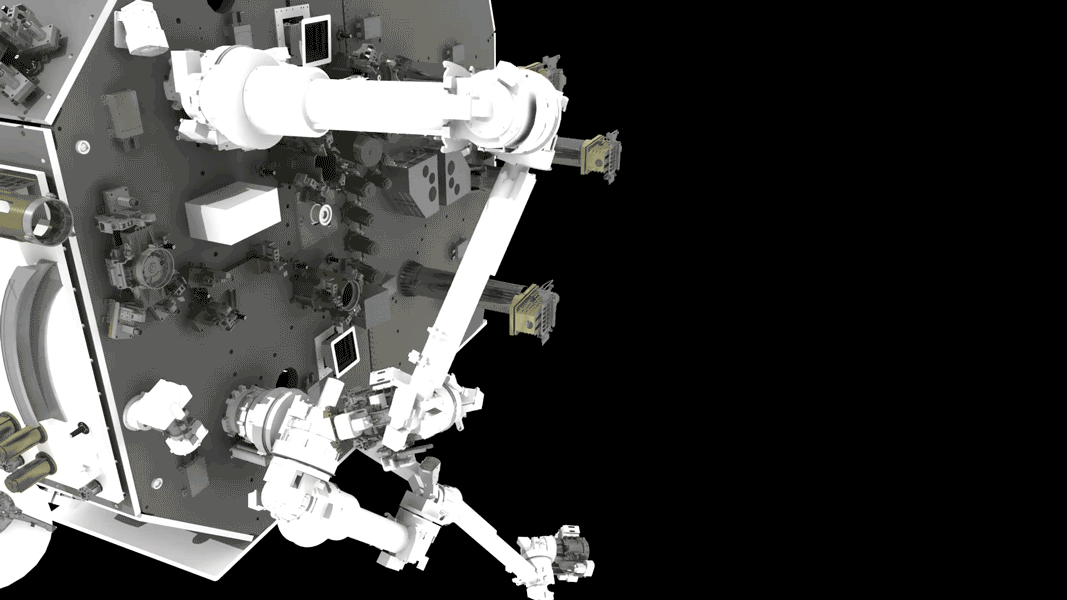NASA
Europa's Icy Shell May Be Habitable for Life
The moon of Jupiter could have shallow water pockets within its frozen surface
Hubble Space Telescope Spots Largest Comet Ever Discovered
The icy object is larger than the state of Rhode Island and weighs an estimated 500 trillion tons
Hubble Telescope Spots the Most Distant Star Ever Detected in Outer Space
The star, nicknamed Earendel, is 28 billion light-years from Earth
Apollo 11 Moon Dust Samples Go Up for Auction Against NASA's Wishes
Auction house Bonhams is expecting around $1 million
Mercury's Cratered Crust May Hold Glittering Gemstones
Fragments of a graphite shell from the planet's past and a series of violent meteorite impacts may have combined to form sparkling diamonds
Genetically Modified Lettuce May One Day Help Space Travelers Fight Bone Loss
The vegetable could provide fresh leafy greens to astronauts' diet while providing a new way to transport and consume medications in the cosmos
Citizen Scientist Captures Glimpse of Jupiter's Moons, Io and Europa, Using Juno Space Probe Data
The natural satellites are seen in the distant background of the gas giant's portrait
Russian Cosmonauts Board Space Station Wearing Blue and Yellow
Roscosmos denies color choice was a show of support for Ukraine
Robots May Soon Fix and Fuel Satellites in Space
Orbiting machines that grip, grapple and maneuver could one day maintain the fleet of small spacecraft that encircle Earth
Hubble Space Telescope Captures Galaxies Caught in Triangular Tug-of-War
A collision between two galaxies may have sparked the odd shape
Long-Term Space Travel May 'Rewire' Astronauts' Brains
The changes may help the organ adapt to microgravity, but they seem to persist for several months after returning to Earth
Was Georgia O'Keeffe's Genius Appreciated Outside of America? And More Questions From Our Readers
You've got questions. We've got experts.
James Webb Space Telescope's First Look at Outer Space Is a Kaleidoscope of Faint Starlight
As NASA astronomers adjust its mirrors over the next month, the dots of light will eventually align into one image of a star in Ursa Major
NASA Plans to Crash the International Space Station Into the Ocean in 2031
The ISS will join other decommissioned spacecraft on the seafloor at Point Nemo, the farthest point from land in the Pacific
Hubble Space Telescope Snaps Stunning Photo of a Faraway Galactic Trio
Some of the galaxies in the image resemble Star Trek’s Starship Enterprise
Intense Lightning 'Megaflashes' Stretched Almost 500 Miles Across Three U.S. States
The bolts, which occurred in 2020, broke records for distance and duration
A Chunk of a SpaceX Rocket Is Going to Slam Into the Moon
After a chaotic orbit of 7 years, the Falcon 9 booster is predicted to crash into the lunar surface this March
First-Ever Archaeological Project Studies How Astronauts Adapt to Their Environments
Researchers on Earth, partnering with those on the International Space Station, are taking a novel approach to understanding the ways humans live in space
'Intriguing' Carbon Isotopes on Mars Could Be From Cosmic Dust, UV Radiation or Ancient Life
NASA scientists compared the data to chemical signatures of biological processes on Earth and found some similarities to billion-year-old microbes
The James Webb Space Telescope Just Cleared Its Most Challenging Hurdle
The tennis court-sized sunshield fully unfurled itself this week, accomplishing the riskiest and most complicated aspect of the telescope's deployment
Page 9 of 37
:focal(800x602:801x603)/https://tf-cmsv2-smithsonianmag-media.s3.amazonaws.com/filer_public/66/15/66158a09-f305-4f5a-8683-8adb284cfac2/europa.jpg)
:focal(492x164:493x165)/https://tf-cmsv2-smithsonianmag-media.s3.amazonaws.com/filer_public/7f/5a/7f5aafd0-2190-40bc-b21f-61f088f2b4d4/hubble_comet_c_2014_un271.png)
:focal(350x297:351x298)/https://tf-cmsv2-smithsonianmag-media.s3.amazonaws.com/filer_public/09/fe/09fe92f1-51f5-4e52-9750-bdc5a8e85612/low-res_engelskjpg.png)
:focal(3360x2240:3361x2241)/https://tf-cmsv2-smithsonianmag-media.s3.amazonaws.com/filer_public/b4/7f/b47f6e6f-2612-495e-8801-63d58f757b1d/lunar_dust_-_close_up.jpg)
:focal(600x451:601x452)/https://tf-cmsv2-smithsonianmag-media.s3.amazonaws.com/filer_public/3c/38/3c386762-b20a-4bee-acb7-e052f06d41bc/439_mercurysubtlecolors1200w.jpg)
:focal(640x360:641x361)/https://tf-cmsv2-smithsonianmag-media.s3.amazonaws.com/filer_public/5b/a3/5ba357bd-dc41-42ce-9b4a-2482108f6b4a/romaine_rotate_resize.jpg)
:focal(492x324:493x325)/https://tf-cmsv2-smithsonianmag-media.s3.amazonaws.com/filer_public/38/bc/38bcde0b-1140-4576-93c4-de6887f8fad6/junocam_jupiter_moons_figureb.jpeg)
:focal(960x539:961x540)/https://tf-cmsv2-smithsonianmag-media.s3.amazonaws.com/filer_public/08/eb/08ebda2d-39da-4286-bb88-8ca2c52f24d8/tgqh6w4qfl4o82zer9wydk.jpeg)

:focal(2472x1227:2473x1228)/https://tf-cmsv2-smithsonianmag-media.s3.amazonaws.com/filer_public/24/98/24986b19-be0d-44c2-a4da-4162a0076481/stsci-01fvyyaynmmdak0yepkx2fjerv.jpeg)
:focal(960x960:961x961)/https://tf-cmsv2-smithsonianmag-media.s3.amazonaws.com/filer_public/5a/e8/5ae8e0c3-dbdc-40c2-92be-470ce1e2306e/1920px-bruce_mccandless_ii_during_eva_in_1984.jpg)
:focal(577x326:578x327)/https://tf-cmsv2-smithsonianmag-media.s3.amazonaws.com/filer_public/8a/a4/8aa4fcb4-f70b-4991-b005-dff82a0f9929/mar2022_a01_asksmithsonian.jpg)
:focal(102x117:103x118)/https://tf-cmsv2-smithsonianmag-media.s3.amazonaws.com/filer_public/e3/c7/e3c79fc5-8ef0-4210-94ea-1e0bd3fd525b/alignment_mosaic_compressed-1536x1041.jpeg)
:focal(3024x2016:3025x2017)/https://tf-cmsv2-smithsonianmag-media.s3.amazonaws.com/filer_public/a4/62/a462dbdc-d839-4962-a995-8c26fe96f3c0/31763901878_d8aa59cb10_6k.jpg)
:focal(545x362:546x363)/https://tf-cmsv2-smithsonianmag-media.s3.amazonaws.com/filer_public/66/b6/66b6b32c-884a-4c01-bc0d-30459f550506/hubble_ngc_7764a_potw2204a.jpg)
:focal(960x539:961x540)/https://tf-cmsv2-smithsonianmag-media.s3.amazonaws.com/filer_public/fb/8f/fb8fb6a9-af3e-46f3-bfe1-db3bc858774e/photo-lightning_as_seen_from_the_geostationary_lightning_mapper_on_noaas_goes-16_satellite_-_042920_-_noaa.png)
:focal(1500x943:1501x944)/https://tf-cmsv2-smithsonianmag-media.s3.amazonaws.com/filer_public/57/f7/57f7ba4b-39fb-4cf9-94ab-ab4666ef9055/gettyimages-463214374.jpg)
:focal(750x500:751x501)/https://tf-cmsv2-smithsonianmag-media.s3.amazonaws.com/filer_public/5a/c7/5ac7e913-8f43-4b96-93ac-a9eb2e08d6ad/iss_nasa.jpg)
:focal(640x457:641x458)/https://tf-cmsv2-smithsonianmag-media.s3.amazonaws.com/filer_public/5a/04/5a0449d9-1f6b-4f45-ae5a-a4c625335f8a/21472_pia22207_1280.jpg)
:focal(2811x2142:2812x2143)/https://tf-cmsv2-smithsonianmag-media.s3.amazonaws.com/filer_public/1e/97/1e97e722-c42d-4f0a-8ea2-2449fe333a91/48936479373_aedba34e60_o.jpg)